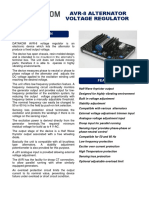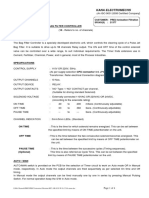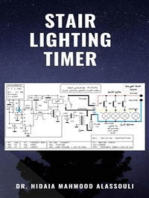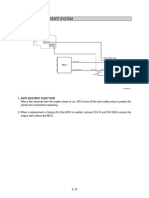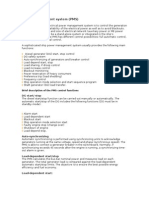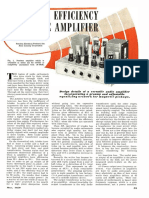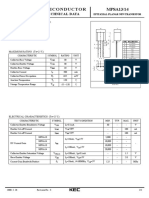68 Ywri Ywri I Ywri CT5 Ywri I CT5
68 Ywri Ywri I Ywri CT5 Ywri I CT5
Uploaded by
George ParaschivCopyright:
Available Formats
68 Ywri Ywri I Ywri CT5 Ywri I CT5
68 Ywri Ywri I Ywri CT5 Ywri I CT5
Uploaded by
George ParaschivOriginal Title
Copyright
Available Formats
Share this document
Did you find this document useful?
Is this content inappropriate?
Copyright:
Available Formats
68 Ywri Ywri I Ywri CT5 Ywri I CT5
68 Ywri Ywri I Ywri CT5 Ywri I CT5
Uploaded by
George ParaschivCopyright:
Available Formats
CURRENT CONTROL RELAYS WITH INITIAL START
UP DELAY & DELAY ON TRIPPING TIMERS PRODUCT
GROUP
TYPES: YWRI, YWRI/I (spco) D
YWRI.CT5, YWRI/I.CT5 (spco)
68
� FEATURES
��Din rail mounted
��SPCO output
��Three selectable input ranges 5mA to 10 Amps
��Dedicated 5 Amp “CT” input version
��Selectable for both AC or DC current
��Selectable manual or auto reset
��Initial start up adjustable time delay 0.1-10 secs
��Adjustable delay on rising current 0.1-10 secs
��Adjustable delay on falling current 0.1-10 secs
��Dual LED indication
� SUMMARY OF UNITS
YWRI - Din rail current sensing relay, selectable via a wired link
for either AC or DC current.
YWRI/I - Din rail “inverse” acting current sensing relay, selectable
via a wired link for either AC or DC current.
� MODE OF OPERATION
CURRENT PROVING SWITCHES AND CURRENT MONITORING RELAYS
YWRI
“Auto Reset” without latching mode. This mode is determined by terminals Y1 & Y2 left open. The output relay is energised
when the monitored current rises above the selected set level, set via the front potentiometer. The output relay will
de-energise when the current falls back below the level selected less the set hysteresis adjustable 5 to 50%, set via a second
potentiometer. For example set level at 4Amps, hysteresis at 30% will result in energisation at 4Amps and de-energisation
at 2.8 Amps. If the auxiliary supply is lost at any time the relay will also de-energise.
“Manual Reset” without latching mode. This mode is determined by a wired link between terminals Y1 & Y2. The output
energises when the monitored current rises above the level selected via the front potentiometer. Once energised the relay
will remain latched even if the monitored current falls below the set level less any selected hysteresis. Resetting is achieved
by opening the link between terminals Y1 & Y2 or by removing the auxiliary supply. If whilst resetting the monitored current
is still above the set level a reset will not be achieved. It is normally preferable in the latching mode to have the adjustable
hysteresis set at minimum.
YWRI/I
“Auto Reset” without latching. This version is only available as an “auto reset” device and the output relay acts in an
“inverse” way, i.e. the output relay is normally energised and de-energises when the monitored current rises above the
level selected via the front potentiometer. It will re-energise when the monitored current falls below the set level less the
set hysteresis adjustable 5 to 50%, set via a second potentiometer. It should be noted that on first connection of the auxiliary
supply the relay will energise for 0.1 secs (i.e. current below the set level), whilst the scanning circuit is determining the
level of current being measured. This time can be extended up to 10 secs via the adjustable “start up delay” thus allowing
a longer stabilisation period.
Adjustable Time Delays
The YWRI and YWRI/I current relays have 3 independently adjustable 0.1-10 secs time delays. Initial start up delay timer,
activated by the connection of the auxiliary supply, therefore if a control circuit is going to be permanently live this time
delay will only ever be active once, a delay on rising current when the monitored current rises above the set level as selected
by the front potentiometer and a delay on falling current, when the monitored current falls below the set level plus the
hysteresis.
� OTHER APPLICATION NOTES
Selection of AC or DC Current
Din rail mounted units can be selected for either AC or DC current monitoring via a wired link between terminals B1 & lK.
B1 & IK linked = DC current. B1 & IK open = AC current.
Use of Current Transformers
The three current ranges are determined by wiring to different terminals. For monitoring currents above 10Amps AC a
current transformer is required. On applications requiring a current transformer with a 5 Amp secondary use the
YWRI.CT5 or YWRI/I.CT5 dedicated current transformer input units. A range of 1 Amp secondary CT’s are available
from our CT section page 156 to 164.
DC Auxiliary Supply Versions
DC auxiliary supply versions are as standard non isolated. For these versions the supply and the measured current must
be isolated from each other and must not exceed 50V DC. On request at extra cost isolated versions can be manufactured
utilising internally a DC to DC converter.
Tel: 0161 626 5316 / 01276 25858 www.foxtamcontrols.co.uk
� SPECIFICATIONS � ORDERING INFORMATION
Supply & Measuring
Nominal supply tolerance: ±15% TYPE COIL VOLTAGE PRODUCT
Isolation AC versions: Via transformer YWRI (Din rail AC or DC current) 440VAC 110VAC GROUP
Isolation DC versions: No as standard or:- YWRI/I (Din rail “inverse” AC or DC current) 415VAC 48VAC
Yes via optional internal DC to DC converter 400VAC 24VAC D
Power consumption: 3VA max 380VAC *48VDC
Hysteresis: Ajustable 5 to 50% of le 230VAC *24VDC
Repeat accuracy: ±2% at constant ambient * No isolation on DC versions as standard, on request at extra cost isolated versions are
±5% across temperature range available. 69
Response time: 100 mSec on make
200 mSec on break
Input ranges selectable: 5-100mA (max overload 5A for less than 1 sec)
50mA-1A (max overload 17A for less than 1 sec)
0.5-10A (max overload 55A for less than 1 sec) SETTINGS
& CONNECTIONS
Input impedances: 100mA range 1 Ohm +
~
1A range 0.1 Ohm
10A range 0.01 Ohm S1
LATCH
Relay output LINK B1-IK
DC CURRENT
Output contacts: SPCO 10Amps/250V AC1 CURRENT RELAY
(Ie) 0.4
0.5 0.6
0.7
Mechanical life: 30 Million ops START UP4 5 6 7
DELAY 3 8
0.3 0.8
A1 11 Y1 Y2 B1 IK
Electrical life: 200K ops at max rated load 2
1
9 0.2 0.9 -/~
0.1 SEC 10 0.1
U 5 6 7 R1
General DELAY 3
4
8
0.05
LEVEL
1
Ie +/~
{
2
I 1 25 30
Operating temperature: -20oC to +65oC 10
9
20 35
12 14 I1 I2 I3 A2
R 0.1 SEC 40
Storage temperature: -20oC to +65oC DELAY 3
4
5 6 7
8
15 5-100mA I1-IK
45 0.05-1A I2-IK
Max cable size: 4mm I 21 9 10
0.5-10A I3-IK
0.1 10
CE marked: Yes SEC
5
HYSTERESIS
50
%
In accordance with: EN61000-6-1: 2007 C O N T R O L S
EN61000-6-3: 2007
EN61010-1: 2002 ~
-
Housing material: Polycarbonate, Auto extinguishable
to UL 94 V-0
FUNCTION
CURRENT PROVING SWITCHES AND CURRENT MONITORING RELAYS
YWRI YWRI/I
S S
I I
Max Max
R R
T1 T2 T3 T2 T3 T1 T1 T2 T3 T2 T3 T1
T2
T1 - Start up Delay T1 - Start up Delay
T2 - Delay on Rising Current T2 - Delay on Rising
T3 - Delay on Falling Current Current
S
Latch
I Max
I Min
R
T1 T2 T3 T2 >T3
TYPES: YWRI.CT5, YWRI/I.CT5 (spco) � SPECIFICATIONS
As an option the YWRI current control relay is available with
Supply & Measuring
a dedicated 5 Amp input designed to work in conjunction Input range: 0.25-5A (max overload 2 5A for less than 1 sec)
with any C.T. with a 5 Amp secondary. The YWRI.CT5 has Input impedances: 0.022 Ohm.
the same mode of operation as the standard versions.
All other specification is the same as the standard YWRI.
� ORDERING INFORMATION
CONNECTIONS +
~
LATCH
TYPE COIL VOLTAGE S1
CT
YWRI.CT5 (Din rail AC current) 440VAC 110VAC
YWRI/I.CT5 (Dinrail“inverse”AC current) 415VAC 48VAC A1 11 Y1 Y2 S1 S2
400VAC 24VAC
380VAC *48VDC R1
230VAC *24VDC
12 14 A2
* No isolation on DC versions as standard, on request at extra cost isolated
versions are available. ~
-
Tel: 0161 626 5316 / 01276 25858 www.foxtamcontrols.co.uk
You might also like
- CG AlternatorsDocument23 pagesCG AlternatorsHitesh Shinde100% (2)
- Vagm 22Document4 pagesVagm 22AONLANo ratings yet
- SF-HC30A3 Manual Sensor de AlturaDocument35 pagesSF-HC30A3 Manual Sensor de AlturaRoberto Medina100% (3)
- Kikusui PLZ-72W, PLZ152W, PLZ152WA, W2 SeriesDocument2 pagesKikusui PLZ-72W, PLZ152W, PLZ152WA, W2 SeriesAsadNo ratings yet
- plz-152wa_w2Document2 pagesplz-152wa_w2AsadNo ratings yet
- SP100-SP103 DatasheetDocument2 pagesSP100-SP103 DatasheetAnt MatthewsNo ratings yet
- Automatic Voltage Regulating Relay EE 301-M: Instruction ManualDocument22 pagesAutomatic Voltage Regulating Relay EE 301-M: Instruction ManualnarendragahlotNo ratings yet
- User'S Manual: Portable High Current Test Set Model Number Hc1Document17 pagesUser'S Manual: Portable High Current Test Set Model Number Hc1Victor Jose Romero FernandezNo ratings yet
- HC 2Document2 pagesHC 2andyNo ratings yet
- Excitation System - 11.05.2011Document52 pagesExcitation System - 11.05.2011vijayrajuNo ratings yet
- Product Information CK110 BoschDocument3 pagesProduct Information CK110 BoschpolitrukNo ratings yet
- Application Examples Application Examples: Ordering CodeDocument2 pagesApplication Examples Application Examples: Ordering CodeRICHARDNo ratings yet
- Avr-8 Alternator Voltage Regulator: DescriptionDocument4 pagesAvr-8 Alternator Voltage Regulator: Descriptionbelbel4321No ratings yet
- RCMA420 Datasheet NAE1042051Document6 pagesRCMA420 Datasheet NAE1042051jmmendesNo ratings yet
- Transformer Switching Transformer Soft Starter Type TSE6-1A......Document6 pagesTransformer Switching Transformer Soft Starter Type TSE6-1A......goguNo ratings yet
- CONTROLLER DOC SDVC21 LinearDocument1 pageCONTROLLER DOC SDVC21 LinearYoga RajanNo ratings yet
- Ae Viva NotesDocument8 pagesAe Viva NotesMayur PanchalNo ratings yet
- Automatic Voltage Regulator (ZIV e-NET Flex Family)Document2 pagesAutomatic Voltage Regulator (ZIV e-NET Flex Family)abbastceNo ratings yet
- 8000 SeriesDocument2 pages8000 Seriesmostafa1alaahobaNo ratings yet
- Avr-8 Alternator Voltage Regulator: DescriptionDocument4 pagesAvr-8 Alternator Voltage Regulator: Descriptionangel ofdarknessNo ratings yet
- Trip RelayDocument32 pagesTrip RelayBambang WinarnoNo ratings yet
- MVCG61 Voltage Dependent Overcurrent PDFDocument10 pagesMVCG61 Voltage Dependent Overcurrent PDFOoi Ban JuanNo ratings yet
- Control Ics For Switched-Mode Power Supplies Tda 4601: Bipolar IcDocument26 pagesControl Ics For Switched-Mode Power Supplies Tda 4601: Bipolar Icbeta2009No ratings yet
- WJ Series High Voltage AC - DC Power Supplies XP Glassman DatasheetDocument3 pagesWJ Series High Voltage AC - DC Power Supplies XP Glassman DatasheetLeonardoMartinNo ratings yet
- PTC Thermistor Relay Series - PD-225Document3 pagesPTC Thermistor Relay Series - PD-225dhir.221016No ratings yet
- Avr8 380 DataDocument4 pagesAvr8 380 DataAlawiNo ratings yet
- Single Phase Automatic Voltage Regulator DesignDocument9 pagesSingle Phase Automatic Voltage Regulator DesignPeter JordanNo ratings yet
- Block Diagram of Arduino Based Over Voltage RelayDocument19 pagesBlock Diagram of Arduino Based Over Voltage RelaydtfrhgfdNo ratings yet
- Sant Longowal Institute of Engineering & Technology, LongowalDocument4 pagesSant Longowal Institute of Engineering & Technology, LongowalMosa Elnaid ElnaidNo ratings yet
- Compact Porosity Detector Datasheet RfsDocument1 pageCompact Porosity Detector Datasheet RfssebincherianNo ratings yet
- Control PFDocument110 pagesControl PFMauro010461No ratings yet
- Kana - Bfc-10-Ch-Std-Ga-Ec-110 VacDocument6 pagesKana - Bfc-10-Ch-Std-Ga-Ec-110 VacJiyaul HaqueNo ratings yet
- LQ Series High Voltage AC - DC Power Supplies XP Glassman DatasheetDocument4 pagesLQ Series High Voltage AC - DC Power Supplies XP Glassman DatasheetLeonardoMartinNo ratings yet
- Single and Three Phase Inverters: World Class Power SolutionsDocument8 pagesSingle and Three Phase Inverters: World Class Power SolutionsMichael BesaNo ratings yet
- ON Semiconductor Is Now: To Learn More About Onsemi™, Please Visit Our Website atDocument44 pagesON Semiconductor Is Now: To Learn More About Onsemi™, Please Visit Our Website atMDG ElectronicaNo ratings yet
- Features: Single or Double Shot Auto Reclose RelayDocument6 pagesFeatures: Single or Double Shot Auto Reclose RelayL AdlyNo ratings yet
- Basler BE1-60 DatasheetDocument8 pagesBasler BE1-60 DatasheetstuartsjgNo ratings yet
- BK - Precision 1602 User ID10907Document16 pagesBK - Precision 1602 User ID10907Andreas KayNo ratings yet
- cd11Document4 pagescd11Jaime DiazNo ratings yet
- Avr40 DataDocument4 pagesAvr40 DataEduardo VicoNo ratings yet
- IntelliRupter PulseCloserDocument24 pagesIntelliRupter PulseCloserThai TranNo ratings yet
- High Current Switching Regulators: DescriptionDocument22 pagesHigh Current Switching Regulators: DescriptionClaudio MartinsNo ratings yet
- Scits 100Document3 pagesScits 100Julio SantacruzNo ratings yet
- Manual DAC-5000VA 110V~220VDocument11 pagesManual DAC-5000VA 110V~220VAndrésNo ratings yet
- KSQ304E2: Automatic Co-Generation Management SystemDocument2 pagesKSQ304E2: Automatic Co-Generation Management SystemRN NNo ratings yet
- L04 - PFCDocument61 pagesL04 - PFCIon AvramNo ratings yet
- Pni Svm-10K/ Pni Svt-10K: Voltage Stabilizer / Stabilizator de TensiuneDocument19 pagesPni Svm-10K/ Pni Svt-10K: Voltage Stabilizer / Stabilizator de TensiuneDamir SuminaNo ratings yet
- AGPower Battery Charger Thyristor Charger Rectifier Ag1Document4 pagesAGPower Battery Charger Thyristor Charger Rectifier Ag1Joseph TingNo ratings yet
- 077 Series Analogue Meter RelaysDocument7 pages077 Series Analogue Meter RelaysMok YukNo ratings yet
- Sx440 Automatic Voltage Regulator (Avr) : Specification, Installation and AdjustmentsDocument4 pagesSx440 Automatic Voltage Regulator (Avr) : Specification, Installation and AdjustmentsJose PirulliNo ratings yet
- PFR-7100 Series Fanless Multi-Range DC Power SupplyDocument16 pagesPFR-7100 Series Fanless Multi-Range DC Power Supplylife4997No ratings yet
- Din Rail 8 & 11 Pin Plug in Dedicated Voltage, Single Time Range, Mains Restoration "Brown Out" TimersDocument2 pagesDin Rail 8 & 11 Pin Plug in Dedicated Voltage, Single Time Range, Mains Restoration "Brown Out" TimersMantenimientoNo ratings yet
- Icm SPMRDocument2 pagesIcm SPMRmahmoud4871No ratings yet
- INGVAR DS enDocument4 pagesINGVAR DS ensyahrianto antoNo ratings yet
- Directional Earth FaultDocument8 pagesDirectional Earth FaultZemenu mandefroNo ratings yet
- ORTEC - Model 480 PulserDocument1 pageORTEC - Model 480 PulserEvgeni TzankovNo ratings yet
- Reference Guide To Useful Electronic Circuits And Circuit Design Techniques - Part 2From EverandReference Guide To Useful Electronic Circuits And Circuit Design Techniques - Part 2No ratings yet
- Reference Guide To Useful Electronic Circuits And Circuit Design Techniques - Part 1From EverandReference Guide To Useful Electronic Circuits And Circuit Design Techniques - Part 1Rating: 2.5 out of 5 stars2.5/5 (3)
- Analog Dialogue Volume 46, Number 1: Analog Dialogue, #5From EverandAnalog Dialogue Volume 46, Number 1: Analog Dialogue, #5Rating: 5 out of 5 stars5/5 (1)
- Cable Tray Standards - by LegrandDocument4 pagesCable Tray Standards - by Legrandsuresh babu100% (1)
- Group 10 Anti-Restart SystemDocument1 pageGroup 10 Anti-Restart SystemDavidNo ratings yet
- Etap Product OverviewDocument12 pagesEtap Product OverviewAsim Idrees OsmanNo ratings yet
- Cenelec: Final Draft en 50174-2 Fpra1Document52 pagesCenelec: Final Draft en 50174-2 Fpra1Arvind SrivastavaNo ratings yet
- Power Management SystemDocument4 pagesPower Management SystemAnkit DedhiyaNo ratings yet
- SC1XHW v15Document34 pagesSC1XHW v15Светлозар АнгеловNo ratings yet
- 4 Bit BCD Adder AbstractDocument4 pages4 Bit BCD Adder AbstractSrinivas SrinuNo ratings yet
- Physics Numerical Ch # 15 (06) 10th by eStudent.pkDocument3 pagesPhysics Numerical Ch # 15 (06) 10th by eStudent.pkA h s a N ツNo ratings yet
- T-Rex Replicator Specs: Tape EchoDocument1 pageT-Rex Replicator Specs: Tape EchoLeonard MedicaNo ratings yet
- Monograph Phase 1Document39 pagesMonograph Phase 1Aziz KhaliliNo ratings yet
- Magnetism Notes 2Document12 pagesMagnetism Notes 2ysfvx6r5zsNo ratings yet
- APS YC500 127 ManualUsuarioDocument26 pagesAPS YC500 127 ManualUsuarioGiovani SoriaNo ratings yet
- PCB3800-TX SpecificationDocument8 pagesPCB3800-TX SpecificationRoberto navarroNo ratings yet
- 1KVA UPS Installation & O&M ManualDocument24 pages1KVA UPS Installation & O&M Manualsarat sahooNo ratings yet
- DatasheetDocument5 pagesDatasheetDaniel Arcia JiménezNo ratings yet
- Omnitronic p-500 1000 1500Document2 pagesOmnitronic p-500 1000 1500videosonNo ratings yet
- The Effect of Light Intensity On Current Generated by A Solar CellDocument8 pagesThe Effect of Light Intensity On Current Generated by A Solar Cellscott blackNo ratings yet
- Priemysel Kompenzacia Aples Technologies Katalog-UDocument3 pagesPriemysel Kompenzacia Aples Technologies Katalog-UAshfaque AhmedNo ratings yet
- 580SA-B Guide en-USDocument2 pages580SA-B Guide en-USdmaruNo ratings yet
- A High Efficiency Triode Amplifier (Peerless A - 100A Amplifier, 6A5G PP, 18W) - Melvin C. Sprinkle (Radio & TV News, May 1950)Document82 pagesA High Efficiency Triode Amplifier (Peerless A - 100A Amplifier, 6A5G PP, 18W) - Melvin C. Sprinkle (Radio & TV News, May 1950)jimmy67music100% (1)
- Datasheet OTB32 DOC-0000393703Document5 pagesDatasheet OTB32 DOC-0000393703Rachel OdendaalNo ratings yet
- Transistor 2021 Pag 1Document2 pagesTransistor 2021 Pag 1StuxnetNo ratings yet
- ELECTRONICS@alinaimanarif PDFDocument41 pagesELECTRONICS@alinaimanarif PDFMazni Hanisah100% (1)
- Generac SizingGuideDocument34 pagesGenerac SizingGuidekaushikray06No ratings yet
- Organization Blocks For Time Delay Interrupt (S7-1200/1500)Document2 pagesOrganization Blocks For Time Delay Interrupt (S7-1200/1500)Mehtab AhmedNo ratings yet
- Порівняння SUN2000-30KTL-M3 VS Solis 30K-5GDocument8 pagesПорівняння SUN2000-30KTL-M3 VS Solis 30K-5GOleksandr AlokhinNo ratings yet
- Service Mode TVDocument26 pagesService Mode TVTvcrepair100% (2)
- SG6961 DatasheetDocument15 pagesSG6961 DatasheetStefanoViganóNo ratings yet
- BT K4411CM2Document2 pagesBT K4411CM2thangtranNo ratings yet



















